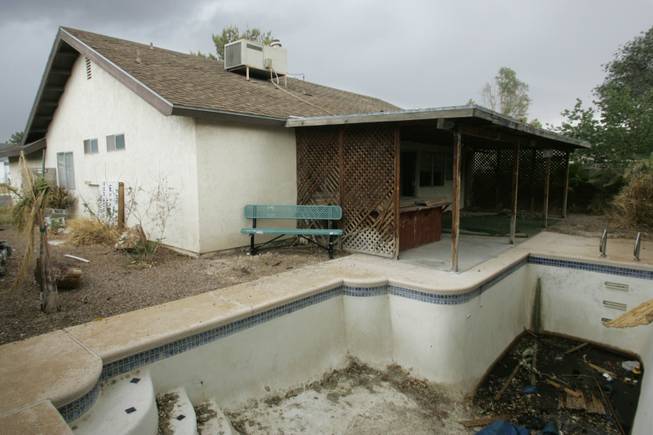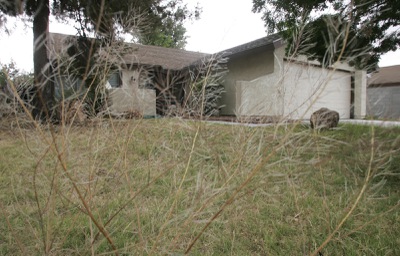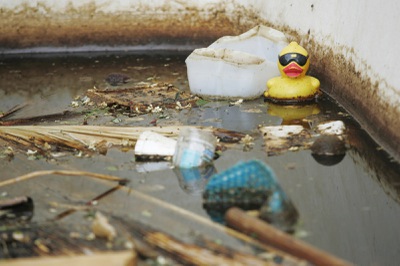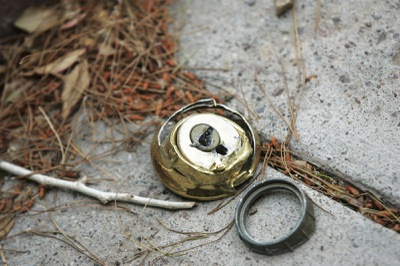
Abandoned homes aren’t always maintained by lenders that take them over. Hazardous pools and brown lawns are becoming commonplace in the valley.
Monday, June 9, 2008 | 2 a.m.
Banks and other mortgage lenders are turning out to be lousy neighbors. Foreclosed homes featuring brown lawns and fetid swimming pools litter the Las Vegas Valley because the lenders that hold title have failed to keep the properties up.
The epidemic is especially acute in neighborhoods regulated by homeowners associations, whose rules require property owners to maintain their properties. Enforcement of those rules is another matter, however.
“There are homes out there with grasses that are burnt,” Sonia Selahi says as she surveys her largely unoccupied Southern Highlands neighborhood from an unusually wide driveway. Her HOA ordered her to broaden it. “The HOA notices us for stupid things,” she complains.
The problems often start before the foreclosure is finalized. The HOA is the first entity homeowners stop paying when they can no longer afford to pay bills, says Mike Krien, president of the National REO Brokers Association and a Las Vegas Valley resident.
Then the lending companies that collect foreclosed properties are, at least initially, often unable or reluctant to maintain them, analysts say. The foreclosure process can take up to four months, creating a lengthy gap in ownership and weeks of finger-pointing.
“There could be six months of fees ... until the property is actually ours,” Krien says.
Also, some homeowners associations have struggled to hold delinquent owners accountable, while other HOAs have had to deal with corporate banks at first — sometimes based abroad — and not with their local representatives. So the payment process drags to a bureaucratic crawl, often from the corporate bank to a local syndicate to a broker, then finally back to the HOA.
Hundreds of hazardous green pools and browning lawns are left in the wake of that process.
•••
Residents of Southern Highlands had no trouble guessing which homes would slip into foreclosure.
“When the foreclosure notice went up, it was no mystery,” says resident Felicia Patin, 37. “We had seen it coming.”
Often properties that have weed-filled, decaying lawns when the homes are occupied tumble into foreclosure. Then the property becomes even more neglected.
The foreclosed home at 3128 Blossom Glen Drive in Henderson is a case in point. The side door to the garage isn’t just unlocked, it’s wide open. Paint and other potentially dangerous materials in there are apparently free for the taking. Inside the house, the floors appear stripped, possibly to the foundation.
Squatters had inhabited this home and other vacant properties nearby, neighbors said.
The major health hazard was in the back yard, where the foot of water left in the pool had morphed — devolved, really — into a murky cesspool of trash, including a small tire, a rubber ducky and a section of a wood fence that had collapsed on the property’s rear boundary. Mosquitoes flew by. A covered, aboveground spa rotted nearby with more dirty water inside it.
As the number of foreclosures has increased annually in the past few years, so have the cases of stagnant swimming pools. Valley residents lodged 1,624 such complaints with the Southern Nevada Health District in 2007, up nearly 600 from the previous year, says Vivek Raman, supervisor of the district’s vector control program.
Five months into 2008, the state’s southern half has almost matched its tally for all of 2006. Through the first three weeks of May alone, the district received 401 complaints.
The fear is these pools can become havens for mosquitoes that can spread West Nile virus and other diseases.
“The pool program should be about a third of our work,” said Raman of his eight-person department. “Right now, it’s about 80 percent.”
•••
At last count, there were 446,358 Nevada households registered as members of HOAs, according to state figures. The state says it won’t have a tally of how many of those are in Clark County until later this year, but given the population distribution and growth patterns around the state, it stands to reason that the majority of those HOA residences are in Southern Nevada.
But about a decade after so many valley neighborhoods sprouted under the watchful, Big Brother eyes of HOAs, foreclosures and vacancies are making a mockery of manicured-lawn mandates and otherwise strictly enforced rules. HOAs don’t make neighborhoods blight-proof after all.
Cash-strapped homeowners can’t pay HOA fees and fines, and the banks and lending companies don’t have the mind-set to do so, says Richard Cherchio, president of The Parks HOA in the Aliante section of North Las Vegas. Krien acknowledges the banks can be slower to repay HOA fees, but only because of the lengthy change-of-ownership process and the fact that brokers often must front the expense for the new title holders.
A few cities in Southern California are now mandating that title holders — even if they’re banks or lending companies — take care of their unoccupied properties so they don’t detract from the value of neighbors’ homes.
It apparently is helping.
“As recently as three months ago, lenders were not willing to help out. Now they are,” says Rick Gibbs, mayor of Murrieta, Calif., one of the cities that adopted the new rule.
No comparable ordinance is being considered in Clark County, however.
Kenny Young, senior assistant to the city manager of North Las Vegas, believes a formalized process isn’t needed. “It’s up to the HOA to decide how vigorously they’ll go after ... the bank,” Young says.
•••
The HOAs, however, may soon try to throw it back to the government if their policies — known as covenants, conditions and restrictions, or CC&Rs — are deemed to have insufficient teeth under state law.
“Our hands are tied statewide,” Cherchio says. “Even when a house becomes vacant or falls into arrears ... we can only go back a certain amount of time to recoup money.”
Indeed, many HOAs have little recourse against delinquent owners.
“The association’s options are the same as for any other owner,” says Elisabeth Shurtleff, spokeswoman for Nevada’s Business and Industry Department. “Unfortunately, with the number of properties affected in the current economic climate, it becomes cost-prohibitive for associations to pursue legal action against the banks.”
Government agencies and HOAs often aren’t certain who holds the titles to these properties. Many of them depend on the county assessor’s office to note the change in ownership, and those updates often lag.
When Raman’s staffers are sent to a green pool, for example, they pour in a treatment to smother the mosquito larvae, then leave a note on the front door instructing the owner to fix the problem.
Of course, many of these homes are empty, so no one is there to clean up the pools.
Raman’s workers must return a few weeks later to give the pool a second treatment, this one lasting three months. For that, they bill the property owner $117.
But who is the property owner? Often, the former owner is still listed as the homeowner of record.
“It becomes a very difficult scenario,” Raman says.




Join the Discussion:
Check this out for a full explanation of our conversion to the LiveFyre commenting system and instructions on how to sign up for an account.
Full comments policy